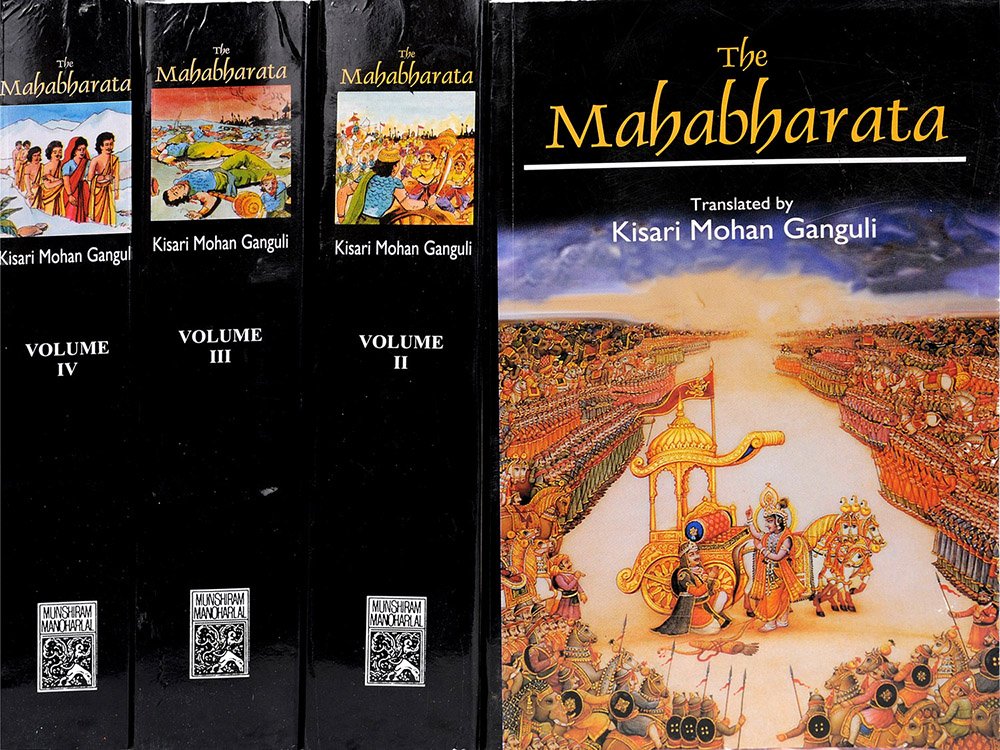Mahabharata (English)
by Kisari Mohan Ganguli | 2,566,952 words | ISBN-10: 8121505933
The English translation of the Mahabharata is a large text describing ancient India. It is authored by Krishna-Dwaipayana Vyasa and contains the records of ancient humans. Also, it documents the fate of the Kauravas and the Pandavas family. Another part of the large contents, deal with many philosophical dialogues such as the goals of life. Book...
Section CII
"Narada said,
'The region where we now are is called Rasatala and is the seventh stratum below the Earth. Here dwells Surabhi, the mother of all kine, she, who was born of the Amrita. She always yields milk which is the essence of all the best things of the earth, and which, excellent as it is, and of one taste, springs from the essence of the six different kinds of tastes (that are talked of). The faultless Surabhi herself sprang in days of old from the mouth of the Grandsire, gratified with drinking the Amrita and vomiting the best things. A single jet only of her milk, falling on the earth, created what is known as the sacred and the excellent "Milky Ocean."
The verge of that ocean all round is always covered with white foam resembling a belt of flowers. Those best of ascetics that are known by the name of the Foam-drinkers dwell around this ocean, subsisting on that foam only. They are called Foam-drinkers because they live, O Matali, on nothing else save that foam. Engaged in the practice of the severest of austerities, the very gods are known to fear them. From her are born four other kine, O Matali, supporting the four quarters and therefore, are they called the supporters of the quarters (Dikpali).
Born of Surabhi herself, she who supports the eastern quarter is called Surupa. She, who supports the southern quarter is called Hansika. That illustrious cow, O Matali, of universal form, who supports the western quarter ruled by Varuna is known by the name of Subhadra. The northern quarter comprising the region of virtue, and called after Kuvera the Lord of treasures, is supported by the cow named Sarva-kamadugha.
The gods, uniting with the Asuras, and making the Mandara mountain their pole, churned the waters of the ocean and obtained the wine called Varuni, and (the Goddess of Prosperity and Grace called) Lakshmi, and Amrita, and that prince of steeds called Ucchaisrava, and that best of gems called Kaustubha. Those waters, O Matali, that yielded these precious things had all been mixed with the milk of these tour cows. As regards Surabhi, the milk she yielded becomes Svaha unto those that live on Svaha, Svadha unto those that live on Svadha, and Amrita unto those that live on Amrita. The couplet that was sung by the dwellers of Rasatala in day of old, is still heard to be recited in the world by the persons of learning. That couplet is this,—Neither in the region of the Nagas, nor in Svarga, nor in Vimana, nor in Tripishtapa is residence so happy as in Rasatala!'"
Conclusion:
This concludes Section CII of Book 5 (Udyoga Parva) of the Mahabharata, of which an English translation is presented on this page. This book is famous as one of the Itihasa, similair in content to the eighteen Puranas. Book 5 is one of the eighteen books comprising roughly 100,000 Sanskrit metrical verses.
FAQ (frequently asked questions):
Which keywords occur in Section CII of Book 5 of the Mahabharata?
The most relevant definitions are: Amrita, Surabhi, Matali, Rasatala, Svaha, Narada; since these occur the most in Book 5, Section CII. There are a total of 21 unique keywords found in this section mentioned 34 times.
What is the name of the Parva containing Section CII of Book 5?
Section CII is part of the Bhagavat-Yana Parva which itself is a sub-section of Book 5 (Udyoga Parva). The Bhagavat-Yana Parva contains a total of 89 sections while Book 5 contains a total of 4 such Parvas.
Can I buy a print edition of Section CII as contained in Book 5?
Yes! The print edition of the Mahabharata contains the English translation of Section CII of Book 5 and can be bought on the main page. The author is Kisari Mohan Ganguli and the latest edition (including Section CII) is from 2012.
